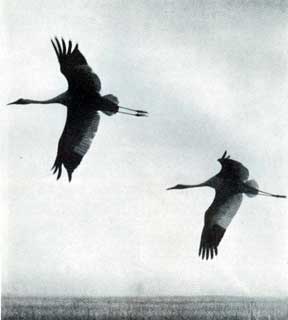A Trumpeter of the Marshlands
By ALBERT DIXON SIMMONS
Nature Magazine, September 1937
Nature painted the plumage of the ptarmigan, the grouse of the moss-covered tundras, with a summer coat of russet-brown that blended perfectly with its surroundings, and a winter coat as white as the snowdrifts. But when she created the whooping crane, Grus americana, she left it with many handicaps. She gave it a trumpet-like voice that can be heard for miles; a deep resonant "w-h-o-o-p" that passes through fully fifty inches of windpipe that is coiled at one end within its breast like the tube of a bugle. She created the tallest and most stately of our North American birds, and she made it all white. Then she stroked its partially bald head with her carmine brush and added jet black wing tips.
Driven to the uninhabited prairies and marshes, harassed through more than a hundred years by collectors and gunners, these rare birds, once legion, now are reduced to a handful that seems to be marked for extinction.

WHOOPING CRANES FLYING LOW OVER THE MARSH WITH NECKS EXTENDED
I had wanted to make photographic records of the flight of blue and snow geese at their winter home in the huge marshes bordering on the Gulf of Mexico. It was in this country that Audubon observed the fall migration of whooping cranes and noted in his diary (1840):
"Reader, see this majestic bird shake its feathers and again arrange them in order. Proud of its beautiful form, and prouder still of its power of flight, it stalks over the withering grasses with all the majesty of a gallant chief".
It was here also, almost one hundred years later, that I was to see and photograph these rare birds. I had left camp at daylight, and winding through the bayous at seventeen knots per hour, my thoughts were with Audubon as he labored here on foot or perhaps poled his pirogue slowly along. A colorful sunrise with nothing but a low narrow fringe of seabrake and mangrove to hide its full beauty, gave promise of a fair day. When I passed through a fresh water lake, thousands of Canada geese took to the air with much honking. A flock of canvas-backs on the water, their backs sparkling in the early morning sun, resembled so many tiny white sails.
And then I saw them! Out on the marsh fully a mile away, their snow-white bodies marked them without the aid of glasses, and their deep trumpet calls easily carried across the distance. Stalking them, even helped by abundant cover, is difficult, because the whooping crane, when on the alert and stretched to its full height, stands five feet high, a natural advantage which enables it to see approaching danger from afar.
Here were two of the rare birds surrounded by nothing but the bare marshland. In open country the sign of movement is lessened by a "beeline" approach, and this was my only choice. The marsh, undermined by muskrats, made each step a problem. As I went into a slight swale in the marsh, I lost my bearings and was guided only by the whooping of the birds. Here again I was further confused by hearing the calls coming from two directions. As I slowly progressed, a group of six more cranes came into view. These birds were down wind, which gave hope that when they took off they might circle up wind and thus present an opportunity of photographing them on the wing.
At a distance of half a mile the cranes were well alarmed. Occasionally one or more of the birds would take to the air, but after a short circling flight, would land again with spindly legs outstretched to meet the ground. Through glasses, I noted the wing beats by stop watch-two per second. Before taking flight they spread their huge wings, then with a quick hop and a smart flip of the wings, were off the ground with neck and feet bobbing at each wing beat. The wing action was short and snappy in that the wing tips traveled through a small arc as compared with, for instance, the loping wings of the great blue heron.
When I was about two hundred yards from the birds, three of them took off, and circling up wind to gain elevation, passed within twenty-five yards of me. The thrill and excitement of the moment will be a lifetime remembrance. The chance to see and photograph the rarest birds on the continent had arrived. The air for the moment was filled with almost deafening trumpet calls. As they passed me one bird was lagging, and I "shot" the two. Then they were gone, flying low over the marsh with necks extended, long black legs thrust straight to the rear, and snow white wings flickering as they were al-ternately thrown into light and shadow. Although they quickly passed from my vision, their vibrant calls and the memory of this experience will remain with me always.
 Printer-friendly version
Printer-friendly version
